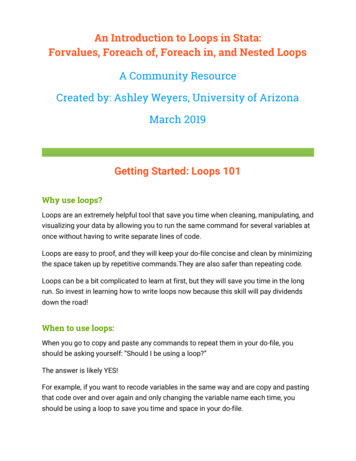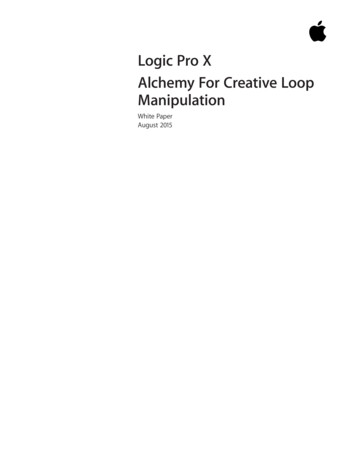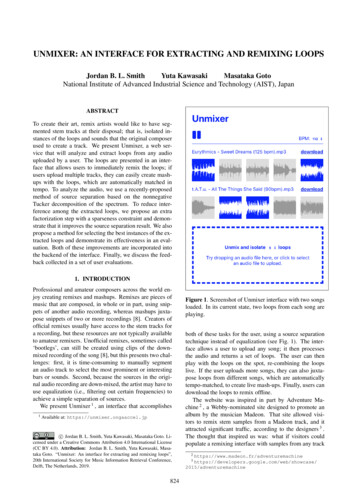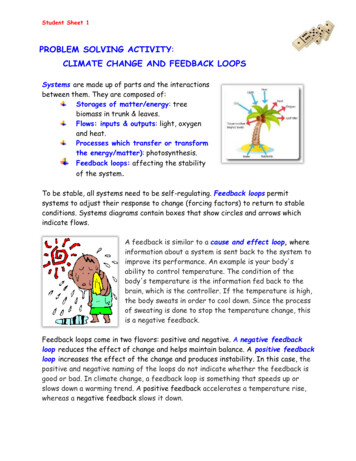
Transcription
An Introduction to Loops in Stata:Forvalues, Foreach of, Foreach in, and Nested LoopsA Community ResourceCreated by: Ashley Weyers, University of ArizonaMarch 2019Getting Started: Loops 101Why use loops?Loops are an extremely helpful tool that save you time when cleaning, manipulating, andvisualizing your data by allowing you to run the same command for several variables atonce without having to write separate lines of code.Loops are easy to proof, and they will keep your do-file concise and clean by minimizingthe space taken up by repetitive commands.They are also safer than repeating code.Loops can be a bit complicated to learn at first, but they will save you time in the longrun. So invest in learning how to write loops now because this skill will pay dividendsdown the road!When to use loops:When you go to copy and paste any commands to repeat them in your do-file, youshould be asking yourself: “Should I be using a loop?”The answer is likely YES!For example, if you want to recode variables in the same way and are copy and pastingthat code over and over again and only changing the variable name each time, youshould be using a loop to save you time and space in your do-file.
2Formatting loops:There are some key components of formatting loops: You have to have an open bracket like this { to start your loop. Note that the openbracket is not indented. It follows the beginning text of your loop. Then, you will go to the second line of your loop. You will need to make an indentbefore you write the content of your loop. What you want to accomplish goeshere. You can have multiple lines of code but each line should be indented. Once you have entered what you wish to accomplish with your loop, you will hitenter to go to the next line. There you will close your loop with a bracket }. Thisshould not be indented. Finally, you will leave a blank line following your loop. This is something you needto do for your loop to run properly in Stata. Note: In the example format below, you will notice that to the left of your codethere is a box with a dash in it, and a vertical line that then hooks to the end ofthe loop. This signals where the end bracket } should be, because there is not anyindented content on that line.Set trace on: Using the command set trace on before you start your loop will help you debugyour loops. When your loop “breaks” (i.e., doesn’t run correctly), it will show you exactly whatpart of your loop is not working.
3You will set trace on before your run your loop(s), and then set trace off after runningyour loop(s).Locals i & j:The most common programming names when writing loops are the local macros “i” and“j”. When written in the content of your loops, i and j should be written with a forwarddirectional in front, and followed by an apostrophe ‘. It must be written this way or yourloop will not work.For example: i’ or j’You will make your claim about “i” and/or “j” first without the forward directional andapostrophe, but include the forward directional and apostrophe around “i” and/or “j” inthe content of your loop. (Reference the example below. I will explain what “forval”means in the following section.)
4Types of LoopsForvaluesForvalues is, arguably, the easiest loop to write. It will only count sequences of numbers,so the variable that you are calling must include numeric values.You can write out forvalues or use the shortened forval command.You will need to distinguish how you want to count through the number sequence.There are a few different options:1. You can loop through a range of number by using a forward slash / between thenumbers you want to loop through. For example, if you had fifteen numbers thatyou wanted to loop through starting at one you would write: forval i 1/15 { tostart the loop.2. You can also loop through a pattern of numbers by denoting that pattern inparentheses ( ) between the number you want to start at and the number youwant to end at. For example, if you wanted to count by 10s from 50 to 100 youwould write: forval i 50(10)100 { to start the loop.3. You can also state the first two numbers of your pattern and use a colon : orwrite “to” the number you want to end the sequence on. For example, if youwanted to count down by twos from 20 to zero, you would write: forval i 20 18 :0 { to start the loop.In the example that I provided (see image below), I am using forvalues to loop throughmothers’ age (MAGER) categories by fives, and generating a new variable (meanprevis)that records the mean number of prenatal visits (PREVIS) during pregnancy per agecategory.
5You can see that I decided to generate my new variable “meanprevis” outside of theloop, this is because I want one variable that includes the mean number of prenatalvisits for each age category that I am requesting. I generated meanprevis equal tomissing.Then, by using forvalues I called age categories by fives, starting at 10-years-old andending at 50-years-old. I asked Stata to put out a summary of the number of prenatalvisits for each age category that I requested (10, 15, 20,., 50). The second part of thebody of the loop asks Stata to replace meanprevis with the mean number of prenatalvisits for each age category.Notice how I also remembered to s et trace on before I started my loop, and turned it offwith set trace off after I closed the loop.We can see from the tabulation (see image below) that the mean number of prenatalappointments increases by age category. There were no observations for the first agecategory (10-years-old), but we can tell from the output that 15-year-olds averagedabout 12 prenatal appointments, whereas 50-year-olds averaged about 17 prenatalappointments.
6Foreach ofYou can use foreach of to create a loop that will pull the list of things you wish to callfrom an indicated place.You can use a loop with foreach of with a: local global varlist newlist numlistIn the example that I provided (see image below), I am using f oreach of generate adummy variable indicating whether or not a pregnant person had an STI or otherinfection during pregnancy. I call five variables (IP * variables) of a varlist and use aloop to replace the value of infect 1 if a person was coded Y (i.e., yes) for having an STIor other infection.
7I chose to use “i” to represent each variable in the variable list, but you could also usesomething more intuitive like “var”: foreach var of varlist {. (But remember that youwould still need to use the forward directional and apostrophe when identifying var inthe body of your loop (e.g., var’).Note that you want to be careful when using foreach of because it has a built in assert,meaning that your code in Stata will break if what you delivered it was not what you saidit was. In many cases, it is safer to use f oreach in .Foreach inForeach in is similar to foreach of , except that you can call a list without specifying alocation. Foreach in is nice because it does not have a built in assert, which lets youloop over things without Stata second guessing what you are trying to accomplish.In the example I provided (see image below), I am using foreach in to generateinteraction variables. I choose to interact whether a birthing person graduated highschool (bp hsgrad) with birthing persons’ age category (bp agecat), race (bp racecat),and whether or not they were a WIC recipient (bp wic).
8You may have noticed that I did not have to specify a location before listing thevariables I was interested in interacting with bp hsgrad. Following foreach in , you simplyneed to list the variables. You do not write any of the locations that follow foreach of(i.e., you do not state whether it is a local, global, varlist, newlist, or numlist).I also used this loop as an opportunity to label my new interaction variables. See, thereare so many ways that loops can save you time!Nested loopsYou can also use loops within a loop to make your work process more efficient. Nestedloops can be as simple or as complex as you want to make them. However, it isrecommended that you don’t go more than three loops deep.To keep things simple, my example (see image below), shows what it would look like tohave one loop nested within a loop.I used a nested loop to create interaction variables between each of the infant disabilityvariables in my dataset (this is denoted by UCA *--the asterisk * signals that I want eachof the six variables that starts with UCA in the dataset) and the dummy variablessmoke (whether the birthing person smoked during pregnancy) and infect (whether thebirthing person had an STI or other infection during pregnancy). This loops will create12 interaction variables. Each of the UCA variables will be interacted with smoke andinfect, so 6 x 2 12.
9You will notice that I used a combination of f oreach of and f oreach in . You can use anycombination of forvalues, f oreach of , and f oreach in with your nested loops. Also, youcan see in the example that the loop within the loop is indented twice, and that loop hasto be closed after indenting, while the outer loop is closed on the following line withoutindenting.Now that you’ve learned about different types of loops in Stata, I encourage you to testout writing some loops for yourself with the practice exercises in the following section.Practice ExercisesIn these exercises, use the auto dataset included in Stata to practicewriting loops. The solutions are in the following section, but try to writeand run the loops on your own before peeking!ForvaluesCreate a loop using forvalues to tabulate whether a car is foreign or domestic (foreign)for cars that get between 18 to 28 miles per gallon (mpg).
10Foreach of/Foreach inCreate a loop that converts the variables measured in inches (length and headroom) tofeet by generating two new variables measured in feet (length ft and headroom ft).Nested loopsUse a nested loop to make cross tabulations of the variables you just created (length ftand headroom ft) with foreign and rep78.
11Solutions to Practice ExercisesForvalues
12Foreach of/Foreach inNested loops
L o c a l s i & j : The most common programming names when writing loops are the local macros "i" and "j". When written in the content of your loops, i and j should be written with a forward directional in front, and followed by an apostrophe '. It must be written this way or your loop will not work.










